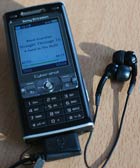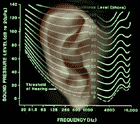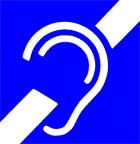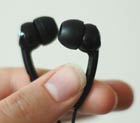



Context - In recent years, sales of personal music players have soared, in particular those of MP3 players. Music from such players has become a significant threat to hearing because it can reach very high volumes and because an increasing proportion of the population is exposed to it, particularly young people. Overall, in the EU, roughly 50 to 100 million people listen to personal music players on a daily basis.
In the light of current scientific knowledge, can the use of personal music players damage hearing?
An assessment by the European Commission Scientific Committee on Emerging and Newly Identified Health Risks (SCENIHR).
The answers to these questions are a faithful summary of the scientific opinion produced in 2008 by the Scientific Committee on Emerging and Newly Identified
Health Risks (SCENIHR): "![]()

1.1 It is well recognised that long-term exposure to excessive sound can harm hearing.
To protect workers, limits have been set for the levels of noise allowed in the workplace.
Environmental sounds to which the general public is exposed - such as noise from traffic, construction, aircrafts or from the neighbourhood - can be very irritating but are in most cases not loud enough to harm hearing.
In the last few years, leisure noise has become a significant threat to hearing because it can reach very high volumes and because an increasing proportion of the population is exposed to it, particularly young people. The cause for concern is not restricted to music from nightclubs and rock concerts, which can be extremely loud, but extends to the new generation of personal music players which can reproduce sounds at very high volumes without loss of quality. Across the EU, many millions of people use personal music players daily and, if they use them inappropriately, they put themselves at risk of hearing damage. More...
1.2 Sound is a form of energy that travels differently through different materials – air, walls, windows etc. In their daily lives, people are not exposed to a single sound but to a combination of different sounds from various sources, which can interfere with each other. Exposure to sounds in general will depend on many factors such as the size and shape of a room and how it is furnished, but also on the anatomy of the ear and hair style of the listener. More...

2.1 When exposed to sound, ears perceive tiny changes in pressure. This sound pressure level can be measured and is commonly expressed in decibels (dB). An average human starts to hear sounds at a certain level that has arbitrarily been defined as 0 decibel.
When sound increases by 20 dB, it represents a 10-fold increase in sound pressure. For instance, the sound pressure of an aircraft taking off nearby (120 dB) is 1000 times greater than that of a normal conversation (60 dB).
Particularly low and high-pitched sounds appear less loud to the human ear. Therefore, sound pressure levels are commonly measured in A-weighted decibels (dB(A)). More...
2.2 Each sound has a specific pattern of frequencies which can be detected by the ear or by different devices (sound meters or artificial ears). Based on the sound pressure measurements it is possible to establish the average level over a period of time, the highest level recorded, or the continuous sound level that would contain the same amount of energy as the sounds heard. More...

The risk for hearing damage depends on sound level and exposure time. For long-term exposure of workers, a working day of 8 hours is typically considered in order to set protections standards. Because sound levels vary in time and from worker to worker, protection standards are expressed as an equivalent continuous sound level that would contain the same amount of energy as the sounds heard.
The EU has established a series of exposure levels above which action should be taken to protect workers. A minimal action level of hearing protection has been set at 80 dB(A) for an 8-hour working day, assuming that below this level the risk to hearing is negligible. This sound level is roughly equivalent to someone shouting or traffic noise from a nearby road.
So far, limits have only been set to protect workers from excessive noise exposure and not for other situations such as the use of personal music players with headphones. The limits are nonetheless relevant to other situations where sound can have harmful effects.
Regularly listening to loud sounds over many hours per day at work entails a similar risk as regularly listening to even louder sounds from a personal music player for a shorter period per day. For instance, being exposed at work to 80 dB(A) during 8 hours per day is equivalent to listening to a personal music player at 95 dB(A) during 15 minutes per day or to an even louder sound of 107 dB(A) during 1 minute per day. More...

4.1 One of the most common forms of hearing impairment is hearing loss, which is the inability of the affected individual to hear sounds below certain thresholds. This can be measured with standard hearing tests. Certain people with normal hearing thresholds can nonetheless have problems understanding speech due to difficulties in processing sounds.
Hearing problems linked to the outer or middle ear can usually be treated, while problems in the inner ear or the auditory nerve going from the ear to the brain are usually permanent. More...
4.2 Hearing loss for high-pitched sounds is typically a result of the ageing process or exposure to loud sounds. Affected individuals can for instance find it difficult to understand speech in noisy situations, such as a party. More...
4.3 Tinnitus is a condition in which a person hears a ringing, buzzing or hissing sound which is caused by the hearing system and not by any external sources. Tinnitus can be temporary or persistent and is relatively widespread. It is often associated with hearing impairment, ageing or exposure to loud sounds, and generally involves the part of the nervous system that deals with hearing. Little is known about its precise causes. Studies show that young people exposed to loud sounds are more likely to have tinnitus than their unexposed peers. More...
4.4 Hearing ability of almost all people slowly gets worse with age. In young adults up to the age of 40, this process is slow and leads to negligible levels of hearing impairment. Among older people, age-induced hearing loss accelerates. More...
Sound-induced hearing loss is irreversible and the best treatment remains prevention. The loss generally builds up slowly over time, but can in some cases be immediate. More...
5.1 Exposure to excessive noise in the workplace is a major cause of hearing disorders worldwide. While exposure at work has decreased in recent years, exposure during leisure time has increased. More...
5.2 Excessive exposure to loud sounds of any type, including music, can harm hearing. The risk has increased due to widespread use of digital personal music players which can produce clear sounds even at maximum volume. More...
5.3 The likelihood that individuals will suffer some hearing loss depends on the sound level, the duration of exposure and their age. Regularly listening to personal music players at high volume settings when young often has no immediate effect on hearing but is likely to result in hearing loss later in life. More...
5.4 Loud sounds can cause small cracks in various parts of the ear and damage various types of cells of the inner ear which in turn affects hearing. For instance, harm to certain sensory cells can induce hearing loss at particular frequencies. Sudden very loud sounds, such as explosions, are a lot more harmful to hearing than steady sounds. More...
5.5 A series of factors can change the way sounds affect us. Prior exposure to safe levels of certain sounds, for instance, can protect the listener from the effects of subsequent exposure to loud sounds, while smoking can worsen the consequences. More...
6.1 Hearing loss can often be detected by hearing tests that determine the minimum volume of sound that the listener can hear at different frequencies. Hearing deficiencies can be noticed at an early stage by testing sensitivity to high-pitched sounds. Other methods used to diagnose hearing loss include direct measurements of the reactions to sounds by the ear or by certain muscles. Temporary or permanent ringing in the ear (tinnitus) can also be an early indication of sound-induced hearing loss. More...
6.2 Some individuals are more vulnerable to excessive sound exposure than others due to genetic or environmental factors. For instance, exposure to loud sounds in combination with other exposures to chemical substances such as heavy metals and organic solvents, or to vibrations may lead to more severe hearing damage than would be expected from sound exposure alone.
Hearing loss can also be caused by several medicines such as certain antibiotics and drugs used to treat cancer and, to a lesser extent, by certain drugs used to fight pain, fever and inflammation, by medication used to prevent malaria and by drugs for reducing water retention. More...
6.3 Sound-induced hearing loss can be treated by ingesting magnesium or steroids, and by breathing in oxygen through a mask or inside a high-pressure chamber. In addition, new drugs with promising results in animal studies have been developed but further research is needed before they can be used to treat humans. More...

Personal music players (and mobile phones with such functions) are not only used to listen to music or to radio programs, but also increasingly to watch videos and pictures or store files.
With the digital formats of sound currently available such as MP3 files, it is possible to reach high sound volumes without quality loss.
The amount of sound energy that reaches the listener’s eardrum depends on the type of music, the way the sound was recorded, in what format it was stored, as well as on the specific characteristics of the music players and of the headphones used. In general, for a given volume setting, ear-bud type earphones lead to a greater sound exposure than other types of headphones. The maximum volume setting on some devices can generate up to about 120 dB(A) which is equivalent to an airplane taking off nearby. More...
8.1 Most users of personal music players choose sound volume settings which are unlikely to cause hearing loss. However, some young people set the volume control very high or listen to music through personal music players for many hours per day, thus risking hearing damage in the long term.
To protect most consumers from hearing damage, a 2004 study recommends limiting listening time to one hour per day and setting the volume to no more than 60% of maximum sound output when using headphones that are placed over the ears and less when using ear-buds. Another study suggests restricting the maximum output level of personal music players to 90 dB(A) in order to limit the risk of hearing loss. More...
8.2 In recent years, sales of personal music players in the EU have soared, in particular those of MP3 players. A growing portion of the mobile phones that are currently sold also include a music playing function but it is not clear how many people actually use it. Overall, in the EU, roughly 50 to 100 million people may be listening to portable music players on a daily basis. More...

Today, adults as well as adolescents and children are increasingly exposed to loud sounds in their leisure time, notably through the use of personal music players. More...
9.1 Studies on young people among the general population have not found an increase in hearing loss over the last few decades. However, some authors stress that if young people continue to listen to music for long periods of time and at high volume levels during several years, they run the risk of developing hearing loss by the time they reach their mid-twenties. More...
9.2 Listening to music from personal music players at maximum volume settings for a few hours can produce a slight temporary hearing loss. Over several years, repeated daily exposures to relatively loud sounds may result in permanent effects, but findings are contradictory. To establish whether exposure of teenagers to music from personal music players may influence their hearing once they get older, long-term studies using more sensitive methods are needed. More...
9.3 Tinnitus, a high-pitched ringing in the ear, is often linked to hearing loss, ageing or exposure to loud sounds. Among young people, there are many reports of temporary or persistent tinnitus induced by loud music, but very few studies have focused on the relationship between the use of personal music players and tinnitus. More...
9.4 The music in nightclubs and rock concerts is even louder than that from personal music players though exposure time is usually shorter. Temporary hearing losses after exposure have been demonstrated, notably among young people attending these events and musicians. However, there is no clear evidence that hearing loss resulting from rock concerts has become more frequent over the last 30 years. In the case of classical musicians, sound exposure occasionally exceeds safe levels, but there is no clear evidence it leads to hearing loss. More...
Exposure to disturbing sounds can have psychological effects. For instance, it can hamper reading, memory, motivation and attention.
Short-term exposure to disturbing sounds, such as road and aircraft noise, affects reading skills and memory. Even if no research so far has determined that the same is true for exposure to music, there is no reason to assume that it should be less harmful to the ability to read and memorise than aircraft, road traffic or speech noise. Listening to music from personal music players while trying to read a text is thus expected to affect how well the text is remembered and how much is learnt from it.
Long-term exposure to continual aircraft noise somewhat affects the ability of children to concentrate and learn. However, there is not enough evidence to conclude whether listening to music through personal music players has any similar long-lasting effect.
Listening to music through personal music players can be beneficial when performing boring and repetitive tasks; however, it may be a hindrance for complicated tasks that require thinking. Music can distract the listeners and isolate them from their environment which can be very dangerous when driving or walking on busy roads.
Exposure to sounds disrupts the sleep of adults but children seem to be less disturbed. Some studies have found a link between aircraft noise and increased blood pressure but it is not possible to conclude that noise caused the changes in blood pressure. Other studies have not found any such effect. Recent reports suggest that people exposed to loud sounds may be at a higher risk of developing certain types of heart disease. More...

11.1 Currently, protection levels have been set to protect workers from excessive noise exposure and these are also relevant to the use of personal music players with headphones. The listening habits of most users of personal music players (and mobile phones including a music playing function) are unlikely to exceed those levels. However, some people may exceed them and put their hearing at risk because they set the volume control very high or listen to music at high levels for many hours per day. The maximum volume setting on some personal music players can generate up to about 120 dB(A) which is equivalent to an airplane taking off nearby. More...
11.2 Prolonged exposure to loud sounds from personal music players (and mobile phones including a music playing function) may lead to temporary or permanent hearing loss, ringing in the ears (tinnitus), and difficulties in understanding speech in noisy environments. Using personal music players can make the listener less aware of potential dangers such as approaching cars. Excessive exposure to noise can also affect memory, reading and learning in children, which could also apply to music from personal music players. More...
11.3 Listening to music, at 80 dB(A) or less is considered safe, no matter for how long or how often personal music players are used. This sound level is roughly equivalent to someone shouting or traffic noise from a nearby road. For sound levels above 80 dB(A), hearing damage may occur if personal music players are regularly used for excessive periods of time over several years. More...
11.4 To better assess the health risks of personal music players, further research is needed on how they are used, on what makes certain people more vulnerable to hearing loss, on effects not related to hearing etc. More...

This summary is free and ad-free, as is all of our content. You can help us remain free and independant as well as to develop new ways to communicate science by becoming a Patron!